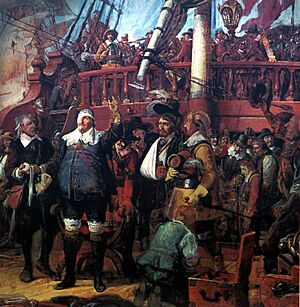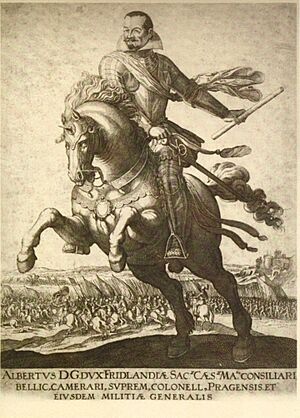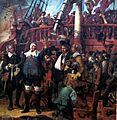Battle of Wolgast facts for kids
The Battle of Wolgast was an important fight during the Thirty Years' War. It happened on September 2, 1628, near Wolgast in what is now Germany. Danish forces led by King Christian IV of Denmark-Norway landed on the island of Usedom and the nearby mainland. They pushed out the Imperial army that was occupying the area.
An Imperial army led by Albrecht von Wallenstein left the siege of Stralsund to face King Christian IV. In the end, the Danish forces were defeated. King Christian IV and some of his soldiers managed to escape by ship.
Quick facts for kids Battle of Wolgast |
|||||||
|---|---|---|---|---|---|---|---|
| Part of Thirty Years' War | |||||||
|
|||||||
| Belligerents | |||||||
| Commanders and leaders | |||||||
|
|||||||
| Strength | |||||||
| 7,000 total 5,000-6,000 in battle |
7,000-8,000 | ||||||
| Casualties and losses | |||||||
| 1,000 killed 1,100 captured |
|||||||
Contents
Why the Battle Happened
King Christian IV of Denmark-Norway joined the Thirty Years' War in 1625. He invaded the Holy Roman Empire with his armies. At first, he had some success. However, his armies were later defeated in big battles like Dessau Bridge and Lutter am Barenberge in 1626.
After these losses, the Danish armies had to leave the lands they had taken in the Empire. They also had to give up parts of Denmark itself. They retreated to the Danish islands. Meanwhile, the Imperial army, led by Albrecht von Wallenstein, took control of the northern German plains.
The Duchy of Pomerania, where Wolgast is located, surrendered to the Empire in November 1627. This was called the Capitulation of Franzburg. But the Baltic Sea remained under Danish control. This was because the Empire did not have a navy.
Emperor Ferdinand II made Wallenstein "General of the Oceanic and Baltic Seas" in April 1628. Wallenstein then started planning to build an Imperial navy with Spain. In response, Denmark and Sweden formed an alliance in April.
The port city of Stralsund, which is west of Wolgast, refused to surrender to the Empire. With help from Denmark and Sweden, Stralsund successfully fought off Wallenstein's siege. King Christian IV also used his strong navy to attack Imperial forces. He landed troops on islands like Fehmarn and in places like Eckernförde. He also destroyed naval bases in cities like Ålborg, Greifswald, and Wismar, which were controlled by the Empire.
The Battle of Wolgast

On August 11, King Christian IV landed on the island of Usedom with 7,000 soldiers. Usedom is separated from Wolgast by a water channel called the Peenestrom. Christian IV's troops quickly took control of the island. They also captured a small fort at Peenemünde, which was at the mouth of the channel.
On August 14, the Danish forces took over Wolgast without any fighting. After the Imperial soldiers were forced out, the local people strongly supported King Christian IV. They wanted to turn Wolgast into a strong fortress, just like Stralsund. More Danish soldiers were on their way from Sweden to help.
King Christian IV then waited for Wallenstein. Wallenstein had stopped his siege of Stralsund and was marching east to fight the Danish army. Christian IV chose a battlefield about half a mile west of Wolgast. This spot was protected by the coast and marshy areas.
King Christian IV had between 5,000 and 6,000 soldiers ready for battle. This included 1,500 cavalry (soldiers on horseback) and about 400 Scottish soldiers. Wallenstein arrived with a larger force of 7,000 to 8,000 troops. His army included 33 companies of infantry (foot soldiers), 20 companies of cuirassiers (heavily armored cavalry), and 11 cannons.
Wallenstein attacked on September 2. He quickly defeated the Danish soldiers on one side of their army. About 1,000 of King Christian IV's troops were killed, and another 600 were captured. After this, Wallenstein's army was able to take back the town of Wolgast. About 500 Danish soldiers were trapped in the town and had to surrender. During the fighting, Wolgast, including the home of the local dukes, was badly burned and looted. Only the darkness of night allowed King Christian IV and some of his soldiers to escape and get back on their ships.
What Happened Next

Peace of Lübeck
The Battle of Wolgast was a major defeat for Denmark. It led to the Peace of Lübeck agreement. This peace treaty basically gave King Christian IV back the lands he had before the war. In return, he promised not to get involved in the Holy Roman Empire's affairs again.
Sweden Invades Pomerania
In 1630, King Gustavus Adolphus of Sweden began his own invasion of the Holy Roman Empire. He landed on Usedom near Wolgast, in the same place King Christian IV had landed earlier. The Imperial soldiers who had been in charge of Wolgast since the 1628 battle were defeated. Gustavus Adolphus's forces took the town on August 7, 1630, and the castle on August 25.
Gustavus Adolphus had more lasting success in the war. However, he returned to Wolgast on July 15, 1633, in a casket. His body was put on a ship there to be taken back to Sweden for burial.
See also
- List of battles
- Thirty Years' War
- Capitulation of Franzburg
- Siege of Stralsund (1628)
- Pomerania during the Early Modern Age
Images for kids



